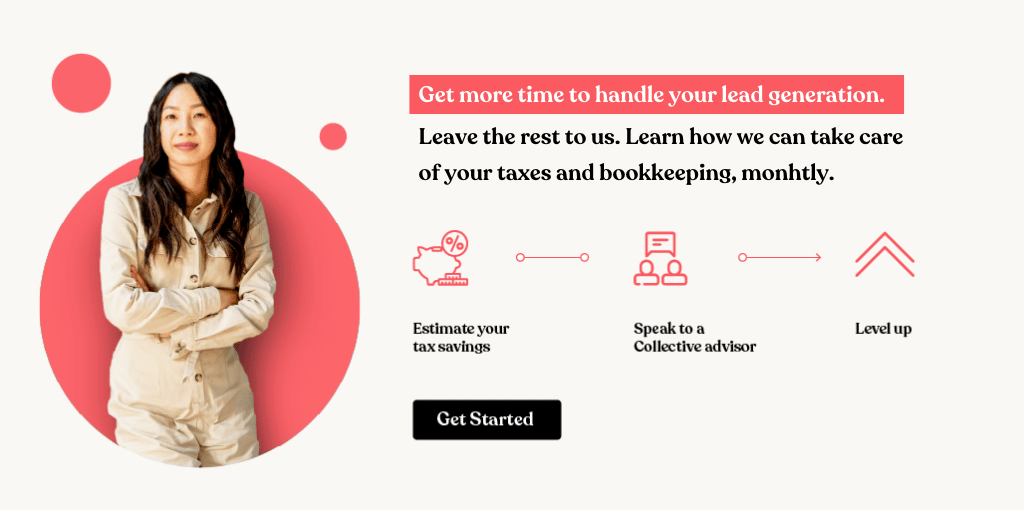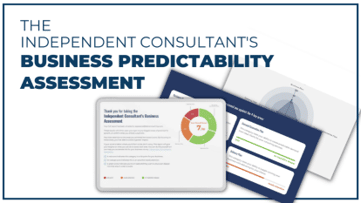It’s common for independent consultants to miss an important step when designing their lead generation process. This blog post will help you make sure you don’t!
What is it? I’ll explain through a story about a recent client of mine, an independent consulting business owner, who I was working with on setting up her lead generation process.
We’ll call her Jane for anonymity’s sake! She recently landed several clients through past colleagues and employers. And now, Jane told me, she was ready to set up a more official lead generation process. She knew her business wouldn’t be sustainable if she relied solely on her immediate network. She wanted to make sure she had control over finding and landing her own clients.
Jane had started putting a lead generation process in place on her own. She set aside a 2-hour block on Fridays for her lead generation activities – networking, speaking, maintaining relationships.
When I asked her to describe her process, she told me she was implementing all the advice she received from other IC colleagues. She wasn’t sure if it would work. And it left her frustrated. Overwhelmed.
She was:
- Sporadic
- Going through the motions
- Not really in control of creating leads.
- Spinning her wheels
- Wasting her time
Jane thought her problem was that she didn’t know how to meet new clients. She wanted me to help her figure out the best way to do it. And a process to uncover if they needed consulting work (or not).
I said, okay we can figure that all out for you, but first let’s make sure you have solid business development fundamentals. I asked her some basic questions about her business goals. And then we both realized what she was missing.
She had never formulated her business development metrics. And, no wonder she was spinning her wheels. You’re probably asking…what are the business development metrics?
I’ll explain by walking you through how Jane and I created her overall lead generation process, so you can replicate this in your own business.
Step 1: Define Your Effective Lead Generation Metrics
Jane’s Case Study: Her Metrics
Jane needed to understand exactly what she wanted her business to look like, in order to create leads that matched that vision.
Jane’s lead generation metrics included:
- Engagement type
- Average contract value
- Number of contracts needed per year
- Annual revenue
- Monthly revenue
- Conversations needed
Without a clear picture of the ultimate goal, Jane knew she would end up taking on clients as they came to her. And, that she would frequently be settling for work she didn’t want to do.
This is what Jane’s metrics looked like:

Establishing Your Business Development Metrics
For you, the first step to establish your effective lead generation process is to define your business development metrics.
Simply put, you need to either know the following numbers or make an educated hypothesis on what they are for each of your service types.
For example, if you have a business that includes Advisory services, strategy work, and delivery, that would be three separate formulas.
Ask and answer the following questions for each service type:
- How many of this type of client do I want this year?
- How many conversations does it typically take me to uncover a potential consulting opportunity? (examples of conversations – 1:1 networking calls, a “catch up” with someone in your network, speaking engagements, etc.)
- What is my close rate?
After you have these crucial numbers (or your best guess if you don’t have a lot of data yet), you can map out your lead generation activities in a chart like Jane’s from the example above.When you break your business down in this way, you get very clear on exactly what you need to be doing to generate the number of leads that makes hitting your revenue goals inevitable, while also making sure you attract clients that need the exact type of work you love doing.

Step 2. Define Your Effective Lead Generation Routine, And Keep It Simple
Jane’s Case Study: Keeping It Simple
After we established Jane’s business development metrics, we set up her routines so she could instill this lead generation process as a new, default habit. We figured out how Jane would create 11 conversations per month.
She identified a variety of methods she could use to easily create these conversations:
- Speaking (there would be more than 11 potential clients in that room, so she could do one of these a month)
- Reconnecting with former colleagues and acquaintances from her corporate life
- Meeting new people via LinkedIn and setting up virtual networking calls
Defining Your Simple and Effective Lead Generation Routine
Now, like Jane, you have your business development metrics in place. What’s next? You can follow this example for your business. For you, think about the answers to these questions:
- Where does my ideal client congregate?
- Where does my ideal client spend time online?
- How do I most enjoy meeting new people?
- How do I most enjoy catching up and maintaining relationships?
It’s important to design a lead generation process that aligns with what you most enjoy, and that also aligns with your ideal client’s typical behaviors.
A word of caution here: I’m not saying, find something that is comfortable for you. Most likely, business development isn’t one of your most advanced skills. You’ll most likely be uncomfortable in this process. That’s okay. That means you’re on track.
Jane’s Case Study: Don’t Fall Into The Consultant’s Trap of Overcomplicating It
So at this point in the process, Jane was clear on her business development metrics and her simple lead generation routine. Jane started to notice some panic and anxiety setting in. She worried:
- Will this be enough to create $540,000 in revenue? It feels too simple.
- Shouldn’t I set up something more automated so it’s scalable? I’ve heard creating a “funnel” is important.
Jane had examples from her past work that told her that 3 conversations per week would be more than enough to hit her goals. Yet she was in this panic mode, worried it wouldn’t work.
Why is this? Jane is a consultant (just like you). That means she’s great at solving complicated problems. She loves solving complicated problems. The flip side of this is that she can overcomplicate things to make them feel more valuable to her.
Can you relate to this? Are you unnecessarily overcomplicating your business development process too? Jane and I worked through her fears about 3 conversations a week not being enough. She agreed it made sense to implement this lead generation process for 60 days, so she could have results to evaluate and adjust as needed.
Step 3. Cultivate An Effective Lead Generation Mindset
Jane’s Case Study: The Final Piece of the Effective Lead Generation Routine
So, at this point, Jane had her business development metrics and routine in place. She had also avoided her typical pattern of overcomplicating things. We were ready to put the final piece to the puzzle in place: an effective business development mindset.
What is it? An effective lead generation mindset is one where you
- Believe you’ll achieve results
- Acknowledge but don’t succumb to doubt
- Are willing to be uncomfortable
- Override the inner critic
- Overcome the second-guessing
- Are committed to achieving the outcome, even if it takes longer than estimated
To cultivate this effective lead generation mindset, Jane and I did a “thought audit”, which is essentially writing down her stream of consciousness about a specific topic.
We uncovered the main belief system standing in Jane’s way was “I’m not good at generating leads because I don’t like selling myself.” Thinking she isn’t good at selling herself was not a productive thought pattern for her, especially as a business owner.
We worked together to shift her thinking about her ability to generate leads. We focused first on her telling herself, “it’s possible I can learn the skills to create leads and sell my work with ease.” This felt so much lighter and do-able for her.
This thought made it much easier for Jane to maintain a consistent routine. And, after repeatedly redirecting herself, Jane started feeling confident and capable as a business owner who fully believes she’s great at lead generation.
Establishing Your Effective Lead Generation Mindset
For you, you can follow this same process Jane and I did:
- Uncover where your thinking will hold you back from achieving the lead generation results
- Figure out how you want to think about yourself as a business owner, as a replacement to the default thinking
- Make a choice to start thinking about yourself in this new way, on purpose.
You’ll start seeing yourself as someone who is becoming confident and skilled at being a business owner who generates leads on demand.
In Conclusion
To establish an effective lead generation routine for your independent consulting business, you want to:
- Get clear on your metrics so you know exactly how many conversations lead to opportunities and how many opportunities become clients. The math makes this so simple and helps you avoid overcomplicating and wasting time in your lead generation process.
- Keep your lead generation routine simple by knowing exactly how many conversations you need to have each week to hit your goals, and by choosing methods that align to how you and your ideal clients like to engage.
- Avoid falling into the consultant’s trap of overcomplicating your lead generation. It’s so common for consultants to inadvertently create problems so they can solve them. Lead generation can be simple if you let it be. Keep your eye out for ways you’re overcomplicating, over-engineering and over-analyzing.
- Cultivate your effective lead generation mindset. The less you think of yourself as someone who isn’t good at business development or lead generation or selling and the more you think of yourself as a business owner who’s fully capable of running a business, is the path to achieving your independent consulting business goals and beyond.
Put This Into Action
To put this information into action:
For more on lead generation:
- Listen to Episode 064 – The 3 Must-Haves for an Effective Consulting Lead Generation Routine
- Listen to Episode 023 – The 3 Consulting Lead Generation Mistakes That Create Underearning from the Grow Your Independent Consulting Business podcast
- Download the Step-By-Step Routine to Fill Your Consulting Pipeline With Ideal Clients in 26 Minutes Per Day
Then, take the Independent Consulting Business Predictability Assessment I’ve created for you. It will help you pinpoint the areas of your business where you’re leaving money on the table, overlooking opportunities, and simply making owning a business harder than it needs to be. Click here to take the Assessment.
| About the Author Melisa Liberman is a fellow independent consultant (for the past 10 years), who has first-hand independent consulting business experience and mistakes under her belt.As a business coach and strategist, Melisa works one-to-one with independent consultants to help them make more predictable revenue and have more impact while working on their own terms.For more resources from Melisa:Listen to the Grow Your Independent Consulting Business Podcast. Take Melisa’s (free) Independent Consulting Business Predictability Assessment to pinpoint your biggest area of opportunity and receive the next 2-3 steps you can take to advance your business with more confidence and ease. |

